Monday, May 24
Steve: This was a spectacular day spent exploring the
vast open plains of the central Serengeti. While yesterday's travels took
us primarily to the woodlands that surround our camp, Nassibu told us that
much of what we were hoping to see in the Serengeti would actually best be
found in the plains. We therefore planned this as a full-day expedition, bringing
a picnic lunch so that we would have 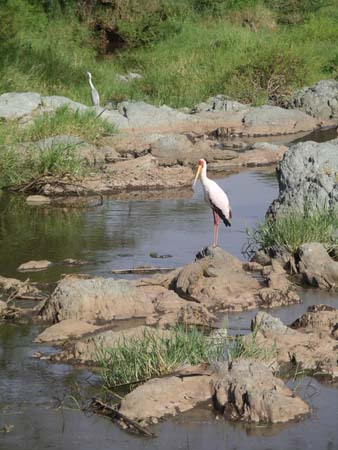 total
flexibility to stay out all day and observe the wildlife. We were also hoping
to be able to see the migration of the huge herds of wildebeest and zebras
that have begun their travel north in search of water - as things turned out,
we were not disappointed!
total
flexibility to stay out all day and observe the wildlife. We were also hoping
to be able to see the migration of the huge herds of wildebeest and zebras
that have begun their travel north in search of water - as things turned out,
we were not disappointed!
Our "Classic Camp" is a permanent camp that Thomson sets up each
year in the Serengeti. We are the only ones staying here at the moment, and
have become spoiled by the attention from the entire staff. Our tents are
large, contain cots with comfortable mattresses, and have attached "toilet
tents."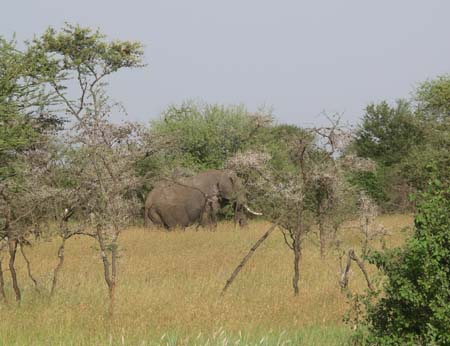 We are even treated to as many hot showers as we want, with the water heated
by wood fire. The food is all prepared in a "kitchen tent", and
has all been wonderful. Our tents look out over grasslands and hills, and
we have been
We are even treated to as many hot showers as we want, with the water heated
by wood fire. The food is all prepared in a "kitchen tent", and
has all been wonderful. Our tents look out over grasslands and hills, and
we have been 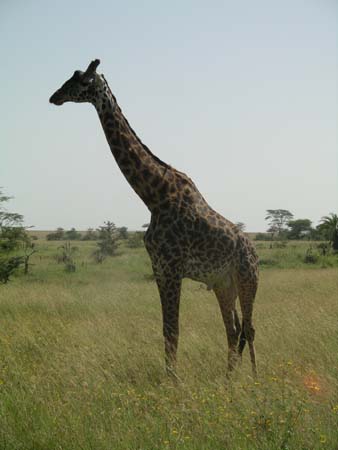 treated
to great sunrises and sunsets each day. What a great base from which to explore
the Serengeti!
treated
to great sunrises and sunsets each day. What a great base from which to explore
the Serengeti!
Soon after leaving camp this morning and entering the boundary of the Serengeti
national park, Nassibu spotted fresh elephant droppings in the road, and told
us to watch carefully. Although elephants are not easy to spot here, (they
are much more plentiful in the Tarangire area where we are headed at the end
of our 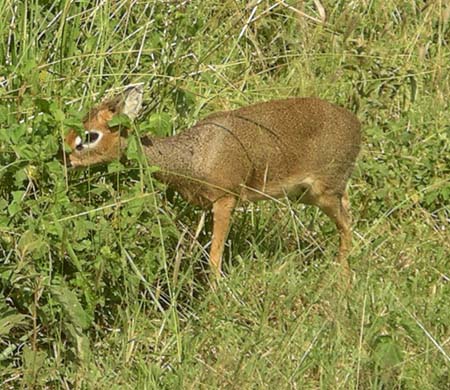 time
in Tanzania). Paula's eagle eyes soon spotted a huge lone bull grazing on
some trees about 100 feet from the road. He was spectacular, and looked huge
even at a distance. The elephants are actually very destructive, and we saw
many trees that they have destroyed in search of food. An elephant will knock
down an entire tree in an effort to reach a specific branch that it has decided
looks particularly tasty.
time
in Tanzania). Paula's eagle eyes soon spotted a huge lone bull grazing on
some trees about 100 feet from the road. He was spectacular, and looked huge
even at a distance. The elephants are actually very destructive, and we saw
many trees that they have destroyed in search of food. An elephant will knock
down an entire tree in an effort to reach a specific branch that it has decided
looks particularly tasty.
Continuing on the main road, we passed several giraffes and impalas. The
giraffes have quickly become on of our favorite animals. They always appear
in large families, and it feels so strange to see such unique creatures simply
grazing along the side of the road. Later in the day, we actually had to stop
our Land Rover for a giraffe that was standing in the road, pulling leaves
off the high branch of a tree.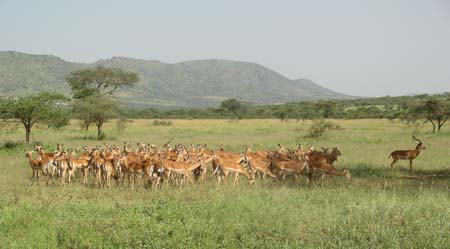
We also saw a particularly large harem of impalas, all carefully guarded by a single male who was busy watching a group of "bachelors" grazing nearby. Interestingly, because the males who own harems spend most of their time protecting their turf and guarding against other males, they are usually quick to lose their harems to other males who have been spending this same time eating and becoming stronger. This was very clear to us today as we watched the male who was totally preoccupied with keeping his harem in order and watching the other males who were quietly eating and minding their own business.
Eventually we entered the open grass plains, and were amazed with just how
open and huge this area is. The word "Serengeti" actually means
"endless plain", and now we understood what this really means. We
found ourselves looking in all directions, for as far as we could see, over
endless fields of grass dotted with occasional acacia trees. Instead of searching
for animals in and among trees, we were instead scanning the horizon in search
of large groups of animals in the distance. 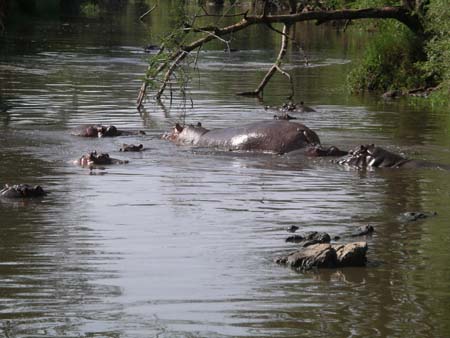
It was also fun to stop by a river where hippos like to cool themselves during the day. We took several pictures, but Nassibu assured us that we'd be seeing many more at close range later during our safari.
One of our primary objectives was to see the annual phenomenon where immense herds of wildebeest, accompanied by zebras, migrate from south to north in search of water. In fact, this migration was one of the driving factors in the overall schedule for our trip to Africa (including the decision to sequence Africa after South America). Although May and June are good times in general to see the migration, we had been warned repeatedly that the migration is unpredictable, and is influenced by many factors, including (most importantly) the weather. However, we were optimistic in being able to view the migrating animals, especially after seeing so many of them from the air yesterday.
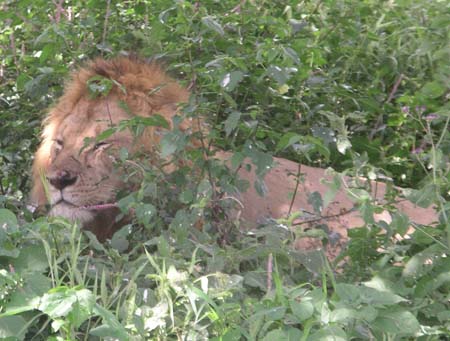 Before
seeing any wildebeest, Nassibu spotted a tree with several perching vultures.
The tree was close to water and Nassibu knew that this was a very likely place
for a lion to be spotted. Sure enough, relaxing right there in the shade of
the tree, was a full-grown male. Although he was lying in deep grass, his
huge size was very apparent and we were thrilled to be seeing our first lion
at such close range. Nassibu thought that this lion had probably recently
completed a large meal and was resting.
Before
seeing any wildebeest, Nassibu spotted a tree with several perching vultures.
The tree was close to water and Nassibu knew that this was a very likely place
for a lion to be spotted. Sure enough, relaxing right there in the shade of
the tree, was a full-grown male. Although he was lying in deep grass, his
huge size was very apparent and we were thrilled to be seeing our first lion
at such close range. Nassibu thought that this lion had probably recently
completed a large meal and was resting.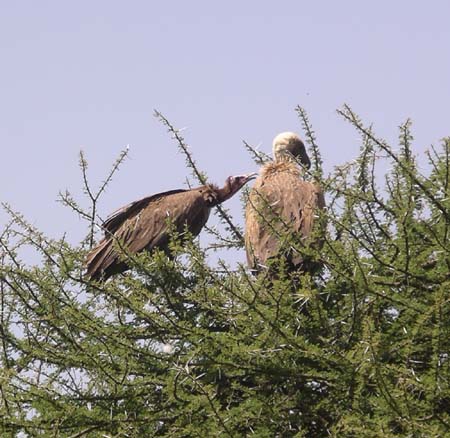 Lions often rest in one spot for 2 or 3 days, so it wasn't likely that this
big guy would be moving anytime soon. Surprisingly, we also learned that the
males do very little of the hunting - most kills are made by the females of
the pride, with a pride consisting of groups of up to 30 lions, including
2-3 males.
Lions often rest in one spot for 2 or 3 days, so it wasn't likely that this
big guy would be moving anytime soon. Surprisingly, we also learned that the
males do very little of the hunting - most kills are made by the females of
the pride, with a pride consisting of groups of up to 30 lions, including
2-3 males.
Nassibu quickly spotted wildebeests on the horizon, and used his 17 years of experience as a safari guide to drive us to an area where he thought that the animals were headed. Even after spotting the animals, it is often hard to predict where they are going, and so although the migration is in full-swing it is possible to not see any of the herds at close range. However, we were extremely fortunate as Nassibu took us to a spot by a watering hole where for two full hours we observed an absolutely amazing herd of wildebeests and zebras as they made their way over the plains, down to a river for a drink, and up the other side to continue their travels.
 We
stopped our Land Rover near the river and watched as a huge line of animals
made their way from as far as we could see on the horizon toward to the river
where we had parked. We could see literally thousands of them as small black
dots, snaking randomly in lines across the wide open plains. Many of the animals
were running, but a large group was starting to form just in front of us as
the lead animals decided to stop before actually entering the river. The front
of the herd was actually made up of a group of 10-12 zebras that were being
extremely cautious, obviously looking and listening for any signs of danger.
These zebras had seemed to take over the lead role for the herd, as the prior
group had actually turned around and were headed back from the direction that
We
stopped our Land Rover near the river and watched as a huge line of animals
made their way from as far as we could see on the horizon toward to the river
where we had parked. We could see literally thousands of them as small black
dots, snaking randomly in lines across the wide open plains. Many of the animals
were running, but a large group was starting to form just in front of us as
the lead animals decided to stop before actually entering the river. The front
of the herd was actually made up of a group of 10-12 zebras that were being
extremely cautious, obviously looking and listening for any signs of danger.
These zebras had seemed to take over the lead role for the herd, as the prior
group had actually turned around and were headed back from the direction that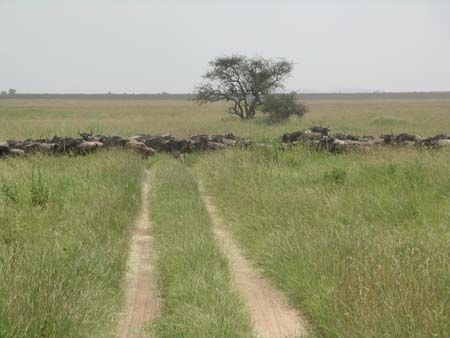 the original herd had come from. They were followed by a line of wildebeests,
and we weren't at all sure whether the main part of the herd would come to
the river where we were, or would simply turn around. Nassibu told us that
their movements were entirely unpredictable…
the original herd had come from. They were followed by a line of wildebeests,
and we weren't at all sure whether the main part of the herd would come to
the river where we were, or would simply turn around. Nassibu told us that
their movements were entirely unpredictable…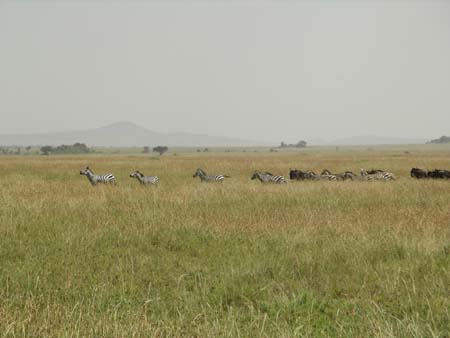
Eventually, the lead zebras became brave enough to head down to the river,
and after the trailing wildebeest saw that the area was safe, they quickly
followed. Soon, we were being treated to an amazing display, as the huge herd
started running, crossing the road directly in front of us. As they approached
the river, many stopped to drink but a surprisingly 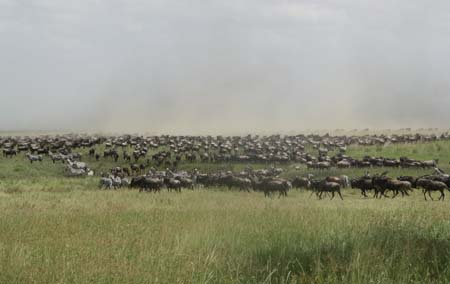 large
number simply ran right through the river and kept going on the other side.
As their numbers increased, we could see that the animals were producing a
huge cloud of dust as they stampeded on the other side of the river. Additionally,
a large group was congregating at the river, obviously deciding that they
needed drinks before continuing on their migration.
large
number simply ran right through the river and kept going on the other side.
As their numbers increased, we could see that the animals were producing a
huge cloud of dust as they stampeded on the other side of the river. Additionally,
a large group was congregating at the river, obviously deciding that they
needed drinks before continuing on their migration.
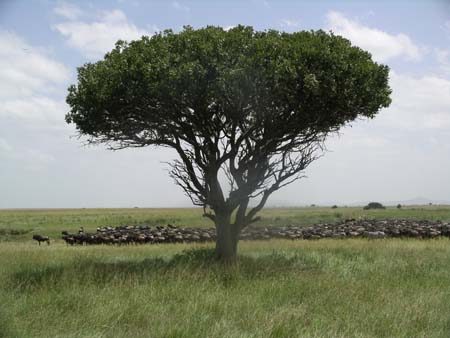 We
ended up staying at this one spot and watching the behavior of these animals
for over two hours, fascinated the entire time. We each enjoyed coming up
with our own theories about what was happening, and all agreed that the zebras
are looked to by the wildebeest for guidance and support. We were
We
ended up staying at this one spot and watching the behavior of these animals
for over two hours, fascinated the entire time. We each enjoyed coming up
with our own theories about what was happening, and all agreed that the zebras
are looked to by the wildebeest for guidance and support. We were 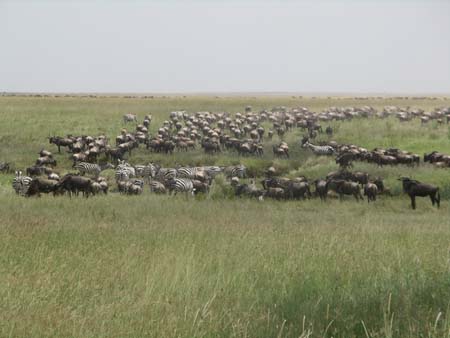 particularly
amused by one specific zebra that almost appeared to be taking count as he
stood and watched as large groups of wildebeests filed by.
particularly
amused by one specific zebra that almost appeared to be taking count as he
stood and watched as large groups of wildebeests filed by.
At one point, Nassibu spotted a crocodile that was quietly approaching the
wate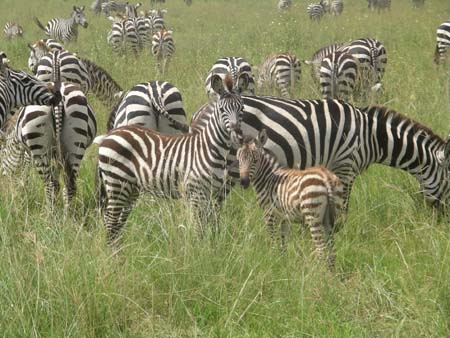 ring
hole where the herd had gathered. He was walking on land, stalking the animals
much the same way that a cat does. We watched intently, hoping to witness
a "kill". The crocodile disappeared under a mound, and we guessed
that he was now waiting in the water (he is much more adept at hunting from
the water than on land). However, despite numerous animals appearing to walk
near where he was hiding, we never saw another trace of him. Nassibu said
that this was the first time he had ever seen a crocodile hunting on land,
so we felt fortunate to have seen this..
ring
hole where the herd had gathered. He was walking on land, stalking the animals
much the same way that a cat does. We watched intently, hoping to witness
a "kill". The crocodile disappeared under a mound, and we guessed
that he was now waiting in the water (he is much more adept at hunting from
the water than on land). However, despite numerous animals appearing to walk
near where he was hiding, we never saw another trace of him. Nassibu said
that this was the first time he had ever seen a crocodile hunting on land,
so we felt fortunate to have seen this..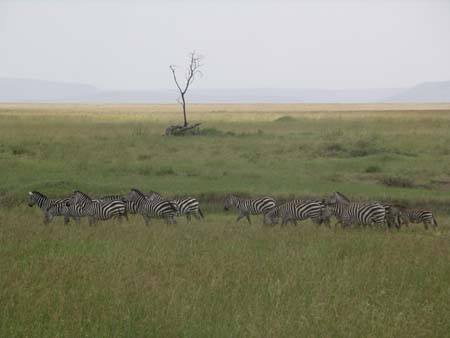
Eventually, the long line of animals came to an end, and we watched as the
final few crossed the water and joined the housands of others who had long
since passed and were now visible only as a cloud of dust in the distance.
Before leaving the area, we returned to the tree with the lion to enjoy our
picnic lunches in his company. As we approached him this time, he appeared
startled and actually sto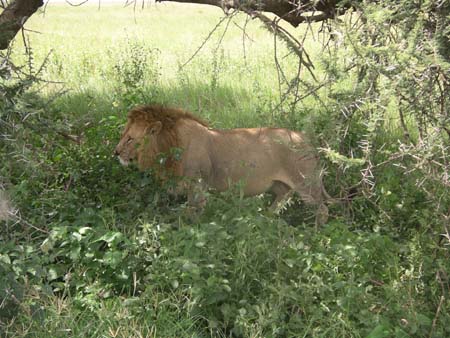 od
for a moment giving us a nice opportunity to see his full size. Needless to
say, we were happy to be sitting in the safety of our Land Rover, although
Paula insisted on closing our windows!
od
for a moment giving us a nice opportunity to see his full size. Needless to
say, we were happy to be sitting in the safety of our Land Rover, although
Paula insisted on closing our windows!
Shortly after we began our drive back north toward our camp, Nassibu shocked
us again with his ability to spot wildlife at amazing distances (especially
impressive since the driving requires particularly close attention to the
road). After taking a closer look with binoculars, Nassibu told us that he
had seen a lion in a tree - a very rare occurrence. 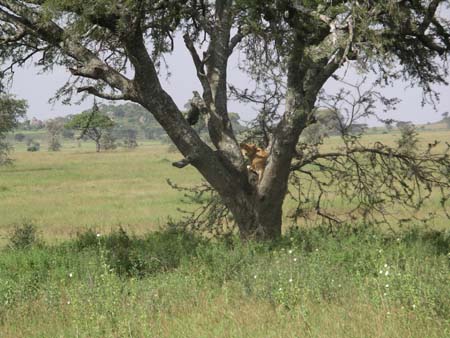 We
then made our way across the patchwork of roads that cut through the plains
to a point where we had a good view of a female perched in the lower part
of a tree (she's in the "Y" in this picture of the tree), several
feet off the ground. Lions hate insects, and this is apparently one
We
then made our way across the patchwork of roads that cut through the plains
to a point where we had a good view of a female perched in the lower part
of a tree (she's in the "Y" in this picture of the tree), several
feet off the ground. Lions hate insects, and this is apparently one 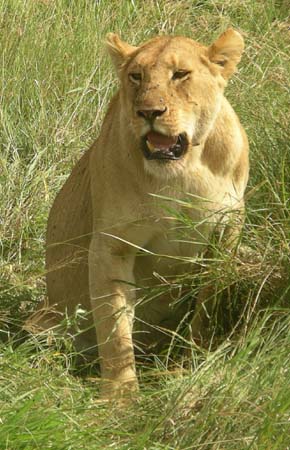 way
that they can relax while escaping the many flies and bugs that live in the
long grasses.
way
that they can relax while escaping the many flies and bugs that live in the
long grasses.
After watching the lion and starting to drive away, we passed another female
directly along the road. She was beautiful, and we were very excited to be
so close and have such a great view of her face. Behind the lion we could
just make out the horn from a wildebeest, apparently her kill from earlier
today (another guide told Nassibu that a lion had been eating her kill earlier
this morning, but we had been unsuccessful in finding the spot until now).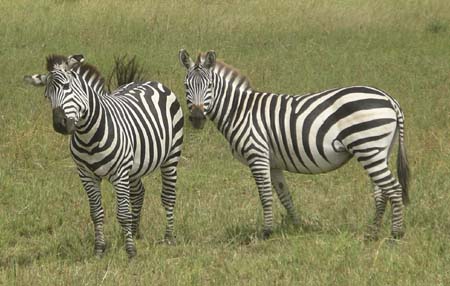
During our drive back to camp, we couldn't stop talking about what had seen and experienced today.
To top it off, we were also treated to another mini-migration of wildebeest that were crossing the road directly in front of us. We stopped to watch and take some more pictures.
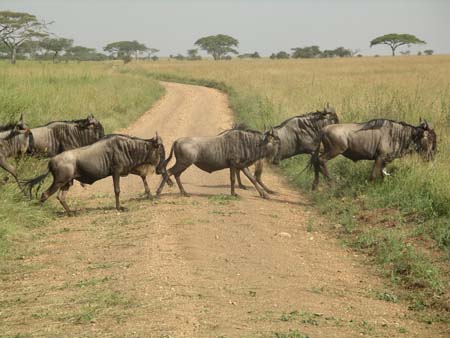
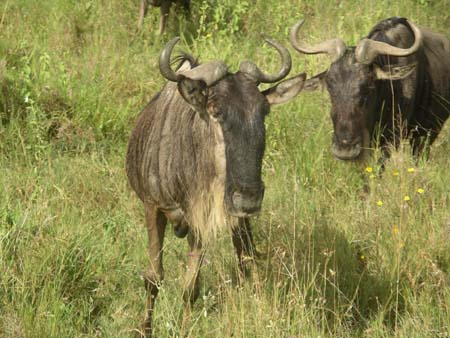
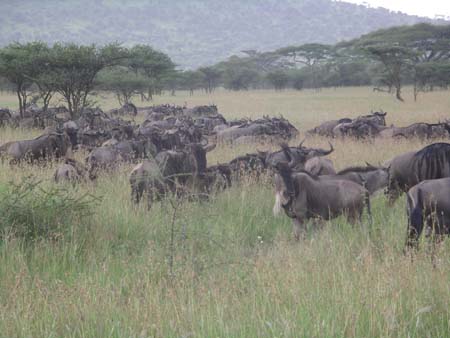
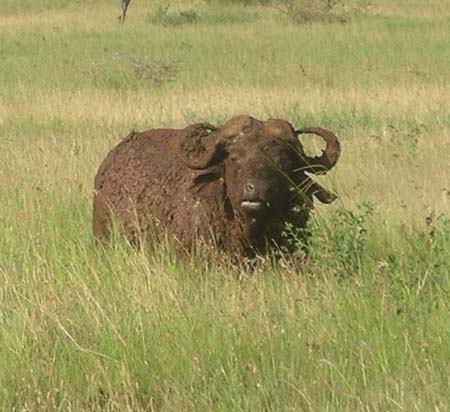
Tomorrow we have another full-day planned in the Serengeti, this time exploring toward the southwest plains which is where we saw the wildebeests heading today.
Animals seen on 5/24:
African Elephant
Impala
Giraffe
Zebra
Topi
Nile Crocodile
Hippopotamus
Cape Buffalo
Kirk's Dik-Dik
Warthog
Waterbuck
Reedbuck
Hartebeest
Ostrich
Leopard Turtle
Cobra Snake
Vervet Monkey
Baboon
NEW Birds seen on 5/24:
Martial Eagle
Ostrich
Hero Eagle Owl
Black Crake
Fisher's Lovebird
Black Headed Heron
Long Crested Eagle
Steel Blue Whita
White Headed Vultures
Sorrowbilled Stork
Hooded Vultures
Egyptian Geese
Lilac Breasted Roller
Pin Tailed Whita
Yellow Billed Heron Stork
Grey Heron
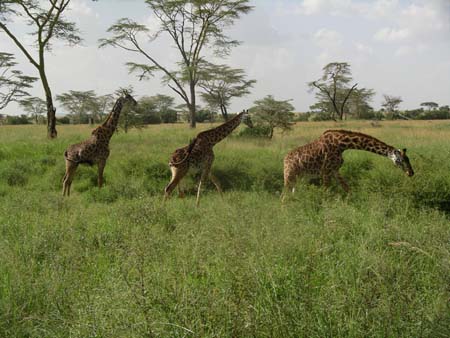
Katie's Kwick Kwacks: First Impressions of the Serengeti. As you look down at the enormous black blobs on the open plains, you know you are in Africa. Only in Africa would you see such a sight. When you land on the rough runway, you look around. The scenery is nothing but open endless plains. It actually seems pretty boring and lifeless until you see movement in the grass. An antelope comes into view. You call out and point in excitement, not knowing the many wonders which await you on that dirt road ahead. This is how I felt during my first five minutes in the Serengeti.
We have learned a lot during our first three days here in the Serengeti.
I have been really interested in observing the animals' social behaviors,
and have found it easy to catch on. For example, now when I see a group of
impalas I can say, "Oh, he has a big harem," or "Look at that
group of lonely bachelors." This has been a really neat experience for
me. So far my favorite animals are the 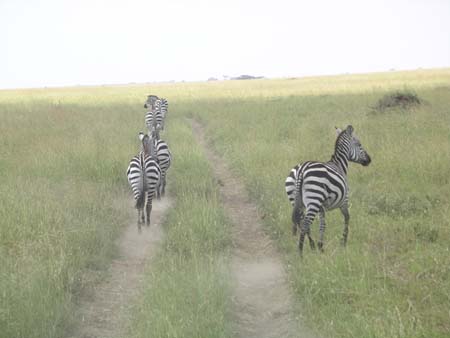 giraffes,
zebras and lions. I find these animals to be the most unique and beautiful
of all the ones I have seen. I especially like how the giraffes run. They
are so tall and have very slender legs making their running majestic and almost
hypnotic. Although before coming to Africa I was afraid of the lions, I have
now decided that I really like them. They look like the kings of the Serengeti
and I think the males are absolutely beautiful!
giraffes,
zebras and lions. I find these animals to be the most unique and beautiful
of all the ones I have seen. I especially like how the giraffes run. They
are so tall and have very slender legs making their running majestic and almost
hypnotic. Although before coming to Africa I was afraid of the lions, I have
now decided that I really like them. They look like the kings of the Serengeti
and I think the males are absolutely beautiful!
Going forward, I am looking forward to seeing new animals and further exploring the secrets and wonders of the Serengeti.
